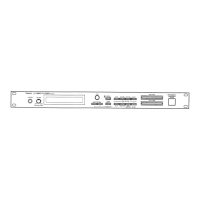For
Nordic
Countries-
Apparatus
containing
Lithium
batteries
ADVARSEL
!
Lithiumbatteri
-
Eksplosionsfare
ved fejiagtig
hSndtering.
Udskiftning
mS kun ske
med batteri
af
samme
fabrikat
og
type.
Lever
det brugte
batteri
tilbage
til leverandoren.
ADVARSEL!
Lithiumbatteri
-
Eksplosjonsfare.
Ved utskifting
benyttes kun
batteri som
anbefalt
av
apparatfabrikanten.
Brukt
batteri
returneres
apparatieverandoren.
VARNiNG
!
Explosionsfara
vid
felaktigt
batteribyte.
Anvand
samma
batterityp
eller
en
ekvivalent
typ
som
rekommenderas
av
apparattillverkaren.
Kassera
anvant
batteri
enligt
fabrikantens
instruktion.
VAROITUS!
Paristo vol
rajahtaa,
jos se on
virheellisesti
asennettu.
Vaihda
paristo
ainoastaan
iaitevalmistajan
suosittelemaan
tyyppiin.
Havita
kaytetty
paristo
valmistajan
ohjeiden
mukaisesti.
For
Germany
Bescheinigung
des
Hersteflers/lmporteurs
Hiermit
wird
bescheinigt,
daB
der/die/das
Roland Mult! Timbral
Synthesizer
Module
JV-880
(Gerat. Typ.
Bezeichnung)
in
Ubereinstimmung
mit
den
Bestimmungen
der
Amtsbl.Vfg
1046/1984
(Amtsblattverfugung)
funk-entstort
ist.
Der
Deutschen
Bundespost
wurde
das
Inverkehrbringen
dieses
Gerates angezeigt
und die
Berechtigung
zur
Oberprufung
der
Serie
auf Einhaltung
der
Bestimmungen
eingeraumt.
Roland
Corporation
Osaka/Japan
Name
des
Herstellers/lmporteurs
RADIO
AND
TELEVISION
INTERFERENCE
For
the
USA-
WARNING
'
This
equipment has
been
verified to comply
with
the limits for
a Class B computing device,
pursuant
to
Subpart
J. of Part
15, of FCC njles.
Operation
with
non-certified
or
non-verified
equipment
is likely to result
in
interference to radio and TV
reception.
The
equipment
described
in
this manual
generates
and
uses radio
frequency energy. If
it is not installed and
used properly,
that
is, in
strict
accordance
with our
instructions,
it
may cause
interference
with
radio
and
television
reception.
This equipment
has been tested
and found to comply with
the limits
for
a Class
B
computing
device in
accordance
with the
specifications
in Subpart
J, of Part
15,
of
FCC Rules.
These
rules are designed
to provide reasonable protection
against
such
a interference
in
a rasidential
installation.
However,
there
is no
guarantee
that the
interference
will
not occur
in a particular
installation. If this equipment
does
cause
interference
to radio
or
television
reception, which
can
be determined
by
tuming
the
equipment
on
and off,
the
user is encouraged
to try
to
correct the
interference
by the following
measure:
•
Disconnect
other
devices
and their
input/output
cables one
at a time. If the
interference
stops, it is caused
by
either
the
other
device or
its I/O
cable.
These
devices
usually
require
Roland
designated
shielded I/O
cables. For
Roland devices,
you
can
obtain the
proper
shielded
cable from
your
dealer. For
non Roland
devices,
contact
the
manufacturer
or dealer
for assistance.
If
your equipment
does
cause
interference
to
i-adio
or television
reception,
you
can try
to correct the interference
by using one
or more
of
the following
measures.
• Turn the TV
or
radio
antenna until
the
interference
stops.
• Move the
equipment
to one
side or
the other
of the TV
or radio.
• Move the
equipment
farther
away
from the
TV or radio.
•
Plug the
equipment
into an
outlet that
is on
a different
circuit than
the TV
or radio. (That is,
make certain the
equipment
and the
radio or
television
set are on circuits
con-
trolled by
different
circuit
breakers
or ftjses.)
•
Consider installing
a rooftop
television
antenna with
coaxial
cable lead-in
between
the antenna and
TV.
If
necessary,
you
should
consult
your
dealer or an
experienced
radio/television
technician
for additional
suggestions. You
may find helpful
the
following booklet prepared
by the
Federal
Communications
Commission;
"How to Identify and
Resolve Radio
—
TV
Interference
Problems"
This booklet
is available
fi^om
the
U.S. Government Printing
Office, Washington,
D.C., 20402, Stock
No. 004-000-00345-4.
For
Canada-
CLASS B
NOTICE
This digital
apparatus
does
not
exceed
the
Class B
limits
for
radio noise
emissions
set
out in
the
Radio Interference
Regulations
of the
Canadian
Department
of
Communications.
CLASSE
B
AVIS
Get
appareil
numerique
ne
depasse
pas
les
limites
de la classe B au niveau
des
emissions
de bruits
radioelectriques fixes
dans le
Reglement
des
signaux
parasites par
le
ministere canadien
des
Communications.

